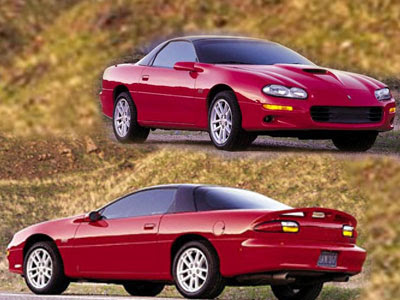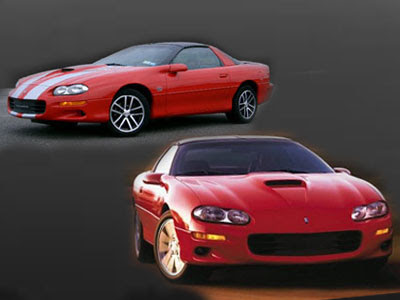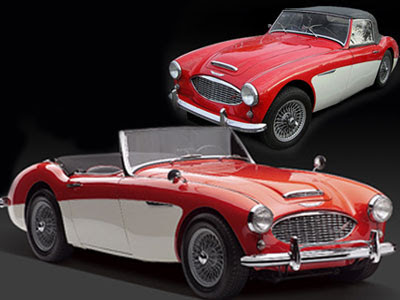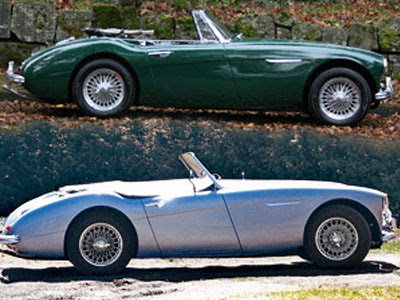2009 Lamborghini Gallardo
The Gallardo is Lamborghini's most-produced model to date, with over 5000 on first three years of production . The car is named after a famous breed of fighting bull. The Spanish word gallardo translates into "gallant," and from Italian into "striking".



2009 Dodge Ram 2500 Mega Cab 4X4
This latest version of the Ram features a number of major innovations and improvements as the timing of this full redesign puts Dodge against fresh versions of its main competitors. The 2009 Dodge Ram has also received a 5-star U.S government crash test rating, the highest rating in the program.



2009 Dodge Grand Caravan
Beginning in 2001, the Generation IV minivans were based on the Chrysler RS platform and featured a larger body frame with modified headlights and taillights. In addition to other detailed changes, power sliding doors and a power hatch became available as options.



Z28 Chevrolet Camaro LS1 V8 Sports Coupe

Z28 Chevrolet Camarore LS1 V8 Sports Coupe
The MK IV Chevrolet Camaro retained the same layout as the very first Camaro's back in 1967, 2-doors, 2+2 seating, rear-wheel drive, choice of V6 and V8 powerplants, and available in both coupe and convertible forms (the convertible was introduced in 1994).
The fourth-generation Chevrolet Camaro debuted for the 1993 model year on the previous generation Camaro platform.

Z28 Chevrolet Camarore LS1 V8 Sports Coupe
The MK4 Camaro featured the 5.7 L (350 cid) LT1 V8 engine that had been introduced in the Corvette one year earlier, as well as an optional six-speed manual transmission. The 1998 model year was refreshed and revised with both exterior and engine changes. Replacing the LT1 was GM's all-new 5.7 L (346 cid) LS1 which had been introduced with the Corvette C5.
The Camaro is to return in 2009 however as a retro styled sports coupe.
The fourth-gen Camaro would last up through the 2002 model year, at which point production was stopped due to slow sales.
Z28 Chevrolet Camaro LS1 V8 Sports Coupe

Z28 Chevrolet Camarore LS1 V8 Sports Coupe
The MK IV Chevrolet Camaro retained the same layout as the very first Camaro's back in 1967, 2-doors, 2+2 seating, rear-wheel drive, choice of V6 and V8 powerplants, and available in both coupe and convertible forms (the convertible was introduced in 1994).
The fourth-generation Chevrolet Camaro debuted for the 1993 model year on the previous generation Camaro platform.

Z28 Chevrolet Camarore LS1 V8 Sports Coupe
The MK4 Camaro featured the 5.7 L (350 cid) LT1 V8 engine that had been introduced in the Corvette one year earlier, as well as an optional six-speed manual transmission. The 1998 model year was refreshed and revised with both exterior and engine changes. Replacing the LT1 was GM's all-new 5.7 L (346 cid) LS1 which had been introduced with the Corvette C5.
The Camaro is to return in 2009 however as a retro styled sports coupe.
The fourth-gen Camaro would last up through the 2002 model year, at which point production was stopped due to slow sales.
Privacy Policy
Each time you visit a website anywhere on the internet various bits of information are being collected to help webmasters track their visitors. Your privacy is very important to me. Bellow are bits of information I gather here on fantastixcars.blogspot.com
Cookies - These are parcels of text sent by a server to a web client (your browser) and then sent back unchanged by the client each time it accesses that server. Cookies are used by websites to identify users who have previously registered or visited the site. For example to keep somebody logged in without them having to enter their password over and over again in order to view each page. Even though fantastixcars.blogspot.com does not use cookies directly, various adverts might be show to you that may well use cookies. These will be coming from 3rd party website I have no access to.
Server logs - These tell me where the visitors are coming from, how long they spend browsing fantastixcars.blogspot.com and what kind of system they have. For example their operating system and screen resolution. I use these stats to make fantastixcars.blogspot.com more accessible. This data is used a whole to identify trends and log any kind of suspicious behaviour. Even though your IP address is being logged it does not actually link to any of your personal information. 3rd party statistics software can be used such as Woopra and Google analytics. These work similar to server logs and can use cookies.
Comments and Posts - Your email address as well as your name/nickname are required for you to make a comment on any of the posts. This information is only used by the commentator system in order to identify you. You are responsible for any kind of personal information you make public in your comments.
Email RSS subscription - You can subscribe to my blog and get new posts delivered straight to your inbox. This is being handled by Google Feedburner. Collected email are not used for anything else but to keep you updated.
Outgoing links - I have no control over the websites I link to. By clicking on the link you proceed at your own risk. It is your responsibility to check privacy policy of the website you are visiting.
Cookies - These are parcels of text sent by a server to a web client (your browser) and then sent back unchanged by the client each time it accesses that server. Cookies are used by websites to identify users who have previously registered or visited the site. For example to keep somebody logged in without them having to enter their password over and over again in order to view each page. Even though fantastixcars.blogspot.com does not use cookies directly, various adverts might be show to you that may well use cookies. These will be coming from 3rd party website I have no access to.
Server logs - These tell me where the visitors are coming from, how long they spend browsing fantastixcars.blogspot.com and what kind of system they have. For example their operating system and screen resolution. I use these stats to make fantastixcars.blogspot.com more accessible. This data is used a whole to identify trends and log any kind of suspicious behaviour. Even though your IP address is being logged it does not actually link to any of your personal information. 3rd party statistics software can be used such as Woopra and Google analytics. These work similar to server logs and can use cookies.
Comments and Posts - Your email address as well as your name/nickname are required for you to make a comment on any of the posts. This information is only used by the commentator system in order to identify you. You are responsible for any kind of personal information you make public in your comments.
Email RSS subscription - You can subscribe to my blog and get new posts delivered straight to your inbox. This is being handled by Google Feedburner. Collected email are not used for anything else but to keep you updated.
Outgoing links - I have no control over the websites I link to. By clicking on the link you proceed at your own risk. It is your responsibility to check privacy policy of the website you are visiting.
Frogeye Sprite Austin Healey the first of several Sprite models
Frogeye Sprite Austin Healey
Frogeye Sprite Austin Healey the first of several Sprite models.
The Austin Healey Sprite which was introduced in 1958 was a diminutive roadster with an unmistakable headlight arrangement.
The prominent headlights were initially intended to be flip-up units. However the cost of retractable headlights was to high, and instead they were fixed in what would have been the 'up' position. Their unusual location gave rise to the cars affectionate nickname, the "Frogeye" Sprite.
The Austin Healey Sprite MK I was powered by a 1.0 litre, inline, four cylinder engine which developed a grand total of 43 horsepower. Coupled to a four speed manual gearbox it was capable of propelling the car up to 84 mph.
The Frogeye Sprite (which was discontinued in 1961) was the first of several Sprite models. In 1962 the MK II Austin Healey Sprite was introduced. The MK II introduced several updates, the most noticeable of which was a more conventional headlight layout. From 1961 the Austin Healey Sprite was also sold as the MG Midget.
The prominent headlights were initially intended to be flip-up units. However the cost of retractable headlights was to high, and instead they were fixed in what would have been the 'up' position. Their unusual location gave rise to the cars affectionate nickname, the "Frogeye" Sprite.
The Austin Healey Sprite MK I was powered by a 1.0 litre, inline, four cylinder engine which developed a grand total of 43 horsepower. Coupled to a four speed manual gearbox it was capable of propelling the car up to 84 mph.
The Frogeye Sprite (which was discontinued in 1961) was the first of several Sprite models. In 1962 the MK II Austin Healey Sprite was introduced. The MK II introduced several updates, the most noticeable of which was a more conventional headlight layout. From 1961 the Austin Healey Sprite was also sold as the MG Midget.
Frogeye Sprite Austin Healey the first of several Sprite models
Frogeye Sprite Austin Healey
Frogeye Sprite Austin Healey the first of several Sprite models.
The Austin Healey Sprite which was introduced in 1958 was a diminutive roadster with an unmistakable headlight arrangement.
The prominent headlights were initially intended to be flip-up units. However the cost of retractable headlights was to high, and instead they were fixed in what would have been the 'up' position. Their unusual location gave rise to the cars affectionate nickname, the "Frogeye" Sprite.
The Austin Healey Sprite MK I was powered by a 1.0 litre, inline, four cylinder engine which developed a grand total of 43 horsepower. Coupled to a four speed manual gearbox it was capable of propelling the car up to 84 mph.
The Frogeye Sprite (which was discontinued in 1961) was the first of several Sprite models. In 1962 the MK II Austin Healey Sprite was introduced. The MK II introduced several updates, the most noticeable of which was a more conventional headlight layout. From 1961 the Austin Healey Sprite was also sold as the MG Midget.
The prominent headlights were initially intended to be flip-up units. However the cost of retractable headlights was to high, and instead they were fixed in what would have been the 'up' position. Their unusual location gave rise to the cars affectionate nickname, the "Frogeye" Sprite.
The Austin Healey Sprite MK I was powered by a 1.0 litre, inline, four cylinder engine which developed a grand total of 43 horsepower. Coupled to a four speed manual gearbox it was capable of propelling the car up to 84 mph.
The Frogeye Sprite (which was discontinued in 1961) was the first of several Sprite models. In 1962 the MK II Austin Healey Sprite was introduced. The MK II introduced several updates, the most noticeable of which was a more conventional headlight layout. From 1961 the Austin Healey Sprite was also sold as the MG Midget.
2009 MINI Cooper Hardtop
The 2009 Cooper Hardtop is a 2-door, 4-passenger family coupe, or sports coupe, available in 3 trims, ranging from the Base to the John Cooper Works. The 2009 Cooper Hardtop is a carryover from 2008.



2009 Jaguar XJ-Series
Jaguar made its name in the 1950s with a series of elegantly-styled sports cars and luxury saloons. Of the more recent saloons, the most significant is the XJ (1968-present), still the definitive Jaguar saloon car for many.



Volkswagen Concept BlueSport Roadster
The Volkswagen Concept BlueSport is a mid-engined roadster concept car produced by Volkswagen. The Concept BlueSport is powered by a 2.0 L (120 cu in) TDI I4 producing around 180 hp (130 kW) and 260 lb·ft (350 N·m). A six-speed dual-clutch DSG gearbox helps give it an estimated 0-60 mph (97 km/h) time of 6.2 sec and a top speed of 140 mph (230 km/h).



2009 Chevrolet Corvette
The Chevrolet Corvette is a sports car that has been manufactured by General Motors (GM) since 1953. There have been six generations of the Chevrolet Corvette produced so far, from C1 through C6; the current C6 generation includes the ZR1, which has the most powerful engine used in a production Chevrolet Corvette to date.
Check out CorvetteGuys.com and their large inventory of
Chrome Corvette Wheels.



Check out CorvetteGuys.com and their large inventory of
Chrome Corvette Wheels.
2009 Mercedes-Benz CLK-Class
The CLK is a mid-sized coupe which is based on a lengthened wheelbase of the compact/entry-level luxury C-Class, so it slots between the C-Class and E-Class in price and size, though Mercedes has positioned it closer to the latter.



2008 Mercedes-Benz CLK-Class
The Mercedes-Benz CLK-Class is a mid-size rear-wheel drive coupé/convertible. While it is based on the C-Class, its styling cues, engine, and price range are closer to that of the E-class, leading some to believe that the CLK is a coupé version of the E-class.



2009 Scion tC "Touring Coupe"
Scion tC is a compact car introduced by Japanese automaker Toyota. The Scion tC was designed for the Generation Y market by making standard features numerous and optional features extremely easy to add. The Scion tC uses the chassis of the Avensis which is sold in the European market, and the Camry's 2.4 L 2AZ-FE I4 engine.



MK III Austin Healey 3000 Improved due to engine modifications.

The Austin Healey 3000
The Austin Healey 3000 was the replacement car for the Austin Healey 100/6. The Austin Healey 3000 was a superior car to its predecessor, equipped with many improved features and updated parts. During its production lifetime the Austin Healey 3000 went through three different versions, the MK I, MK II and MK III.
The Austin Healey 3000 MK I (1959 - 1961) was fitted with a 3.0 litre inline six cylinder engine developing 124 horsepower. The engine was equipped with twin SU carburetors. And the car featured disc brakes at the front.
The Austin Healey 3000 MK II (1961 - 1963) introduced several improvements and design changes. The engine was enhanced by the fitment of triple SU carburettors which bumped the power up to 132 horsepower. In 1962 the BT7 2+2 version was introduced. This seating layout became the only option from 1962 onwards. The Austin Healey 3000 MK IIa introduced wind-up windows, a curved windscreen, and a convertible hood.

The Austin Healey 3000
The Austin Healey 3000 MK III (1963 - 1967) was the final version of the 3000 model. The performance was improved due to engine modifications. Peak power was raised to 148 horsepower, giving the 3000 MK III a top speed of 120 mph. The brakes were also enhanced with the fitment of a servo.
In 1967, due to new safety regulations in the cars biggest market - America, the Austin Healey 3000 was discontinued. It's replacement, the MGC, was nowhere near as popular as the Austin Healey 3000.
During its lifetime the Austin Healey 3000 proved to be a capable racing car. And it competed successfully in rally and road races around the world.
MK III Austin Healey 3000 Improved due to engine modifications.

The Austin Healey 3000
The Austin Healey 3000 was the replacement car for the Austin Healey 100/6. The Austin Healey 3000 was a superior car to its predecessor, equipped with many improved features and updated parts. During its production lifetime the Austin Healey 3000 went through three different versions, the MK I, MK II and MK III.
The Austin Healey 3000 MK I (1959 - 1961) was fitted with a 3.0 litre inline six cylinder engine developing 124 horsepower. The engine was equipped with twin SU carburetors. And the car featured disc brakes at the front.
The Austin Healey 3000 MK II (1961 - 1963) introduced several improvements and design changes. The engine was enhanced by the fitment of triple SU carburettors which bumped the power up to 132 horsepower. In 1962 the BT7 2+2 version was introduced. This seating layout became the only option from 1962 onwards. The Austin Healey 3000 MK IIa introduced wind-up windows, a curved windscreen, and a convertible hood.

The Austin Healey 3000
The Austin Healey 3000 MK III (1963 - 1967) was the final version of the 3000 model. The performance was improved due to engine modifications. Peak power was raised to 148 horsepower, giving the 3000 MK III a top speed of 120 mph. The brakes were also enhanced with the fitment of a servo.
In 1967, due to new safety regulations in the cars biggest market - America, the Austin Healey 3000 was discontinued. It's replacement, the MGC, was nowhere near as popular as the Austin Healey 3000.
During its lifetime the Austin Healey 3000 proved to be a capable racing car. And it competed successfully in rally and road races around the world.
Subscribe to:
Posts (Atom)